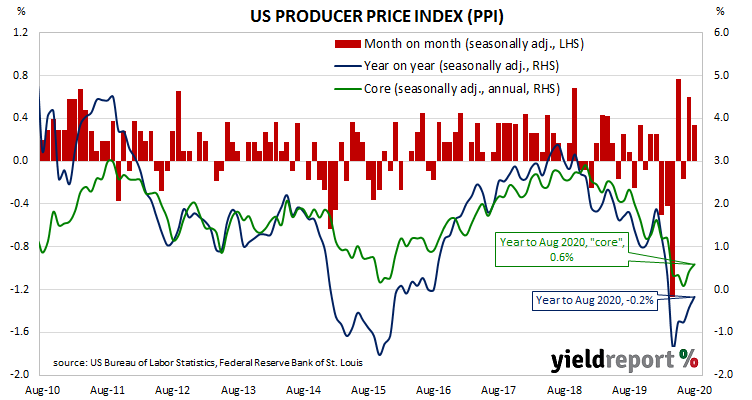Summary: Prices received by producers increase by 0.3% on average; rise slightly higher than expected; annual “core” PPI continues moves away from zero; long-term US bond yields decline on day; PPI rise predominantly driven by higher services prices.
Around the end of 2018, the annual inflation rate of the US producer price index (PPI) began a downtrend which then continued through 2019. Months in which prices received by producers increased suggested the trend may have been coming to an end, only for it to continue, culminating in a plunge in April. Figures from subsequent months suggest a return to “normal”.
The latest figures published by the Bureau of Labor Statistics indicate producer prices rose by 0.3% after seasonal adjustments in August. The increase was above the 0.2% rise which had been generally expected but also half July’s 0.6% rise. On a 12-month basis, the rate of producer price inflation after seasonal adjustments increased to -0.2%, up from the -0.4% annual rate recorded in July.

PPI inflation excluding foods and energy rose by 0.4% after recording increases of 0.5% in July and declines of 0.3% in June. The annual rate increased from 0.4% to 0.6%.
Longer-term US Treasury bond yields finished lower. By the end of the day, the 10-year yield had lost 2bps to 0.68% and the 30-year yield had shed 4bps to 1.42%. The 2-year yield finished 1bp higher at 0.14%.
The BLS stated higher prices for final demand services were the main drivers of the month’s increase after they rose by 0.5% on average. Prices of goods increased by just 0.1% on average.
The producer price index (PPI) is a measure of prices received by producers for domestically produced goods, services and construction. It is put together in a fashion similar to the consumer price index (CPI) except it measures prices received from the producer’s perspective rather than from the perspective of a retailer or a consumer. It is another one of the various measures of inflation tracked by the US Fed, along with core personal consumption expenditure (PCE) price data.

